The Great Lakes are made up of five lakes near the border of the United States and Canada: Lake Superior, Huron, Michigan, Erie, and Ontario. With a total surface area of 94,600 square miles, there’s no shortage of amazing critters to find here – including these 8 Great Lakes snakes!
Snakes are an important part of the ecosystem. They help control pests and act as a valuable food source to certain predators, such as hawks and other large birds. Learning more about them can help keep you and them safe on your trip to the Great Lakes.
Ready to learn more about these 8 fascinating snakes? Keep reading!
Eastern Garter Snake

The eastern garter snake is a common Great Lakes snake.
©iStock.com/Robert Winkler
The eastern garter snake is a non-venomous snake common across North America, including the Great Lakes. Although it is non-venomous, it can be aggressive. It also may release a foul-smelling musk as a warning sign before striking.
Otherwise, though, the eastern garter snake is a relatively harmless native to this area. It is rather small, only reaching a length between 18 to 26 inches long. Though its colors may vary from dark brown to green, you can typically identify it by the stripes. It has one yellow or white stripe running down its center, as well as two smaller, light-colored stripes on either side.
These little snakes are able to thrive in the Great Lakes because of their diet. While they eat a variety of insects, such as earthworms, they also enjoy amphibians like frogs, toads, salamanders, and even small fish. They are, however, a common prey for bullfrogs and other, larger snakes.
Northern Watersnake
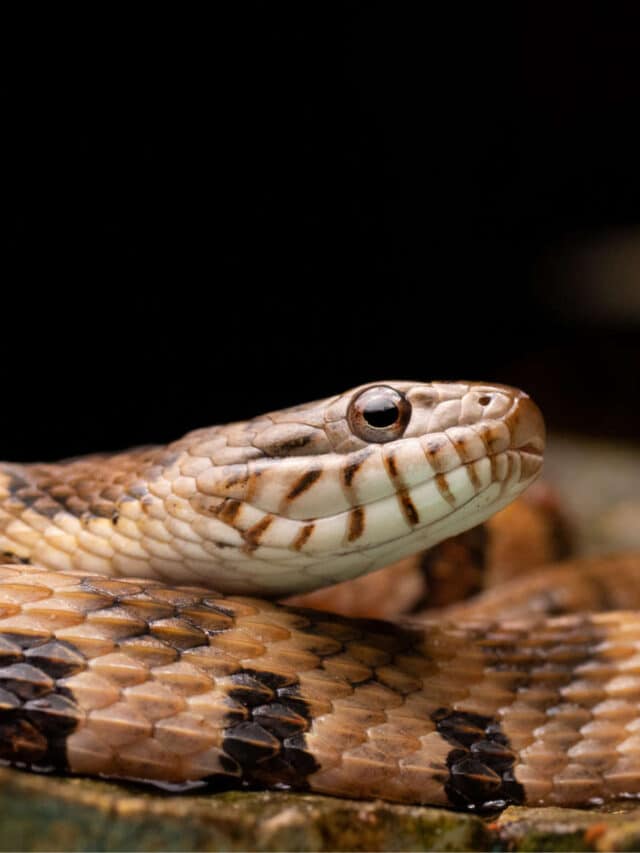
The northern watersnake can resemble many other species.
©Radiant Reptilia/Shutterstock.com
The northern watersnake is another common Great Lakes snake. It is larger than the eastern garter snake, however, reaching sizes of anywhere from 24 to 42 inches. While this is average, it can grow larger, with one record-breaking specimen in Virginia reaching 54.1 inches. Although it is found throughout North America, the bright waters of the Great Lakes make the perfect habitat for this snake.
In fact, there is one subspecies of northern watersnake found only in the Great Lakes! The Lake Erie watersnake was the 23rd species to be taken off the list of endangered species after successful efforts to restore its population. Once dwindling to almost nothing, the Lake Erie watersnake population now thrives with tens of thousands of snakes.
The northern watersnake can easily be confused with the northern cottonmouth. However, because cottonmouths are only found in the southern regions of the United States, you won’t need to worry about that dangerous mistake in the Great Lakes. The northern watersnake is completely non-venomous.
Eastern Massasauga Rattlesnake

The eastern massasauga rattlesnake is one of the venomous Great Lakes snakes.
©Ryan M. Bolton/Shutterstock.com
The eastern massasauga rattlesnake is one of only two rattlesnakes that you can find in the Great Lakes region. It also happens to be the only venomous snake in all of Michigan.
You’ll find that this snake isn’t too far off from its rattlesnake cousins in terms of appearance. It has a heavy body that tends to be fairly wide, and a large head with venom glands. However, it is also one of the smallest species of rattlesnake. This means that it won’t often grow to be more than five feet long.
Thankfully, you’ll often know you’ve encountered an eastern massasauga rattlesnake before a bite. Like all rattlesnakes, it has a rattler on its tail that will act as a tell-tale warning if you’ve come too close. They’re also pretty shy and will prefer to flee – unless you harm them or startle them. Like with all venomous snakes, a bite is a medical emergency, so you’ll want to seek immediate care if one does occur.
Kirtland’s snake

©Mike Wilhelm/Shutterstock.com
Kirtland’s snakes are a popular sight at the Great Lakes thanks to their love for the water. They’re fairly small – usually reaching no more than 18 inches in length – which can make them easy to miss, but they’re often in contact with everyone from hikers to boaters. Like many other snakes on this list, they’re found throughout the United States.
At a glance, the Kirtland’s snake can look intimidating. It has a dark body and dark markings that make it look like many species of venomous snakes that are common around the United States. However, this frightening appearance is for their own protection. Not only are they not venomous but they’d much rather flee and hide than confront a human. In fact, there’s actually no record of a Kirtland’s snake ever biting anyone!
Northern Ribbon Snake
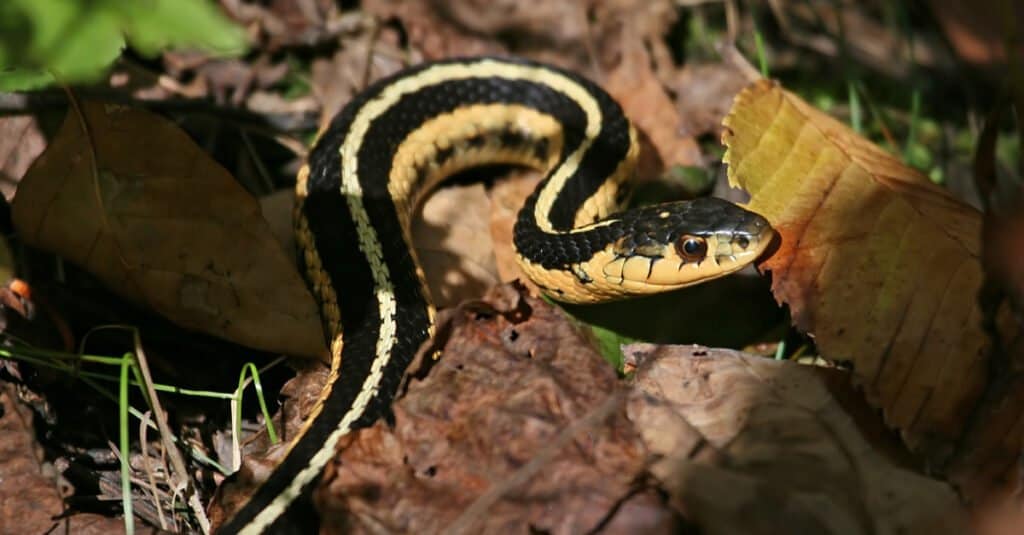
This northern ribbon snake is related to the garter snake!
©John Czenke/Shutterstock.com
The northern ribbon snake is actually a subspecies of the garter snake, which is why they may look so similar. And, since both can be quite common in the Great Lakes, it can be easy to mix them up. However, unlike their garter snake cousins, the northern ribbon snake has black scales on the bottom of its mouth, a feature unique to them. This can help identify this small, harmless Great Lakes snake.
At their largest, northern ribbon snakes reach lengths up to 26 inches. This size plays a role in their diet, which is mainly made up of worms and small insects. However, because they are one of many Great Lakes snakes, they’re also known to eat small frogs and fish as well.
Because the northern ribbon snake is so skittish, you may never get to see one up close. However, if you’re careful enough and watch from afar, you may get to catch a glimpse of them slithering near the Great Lakes.
Northern Red-Bellied Snake
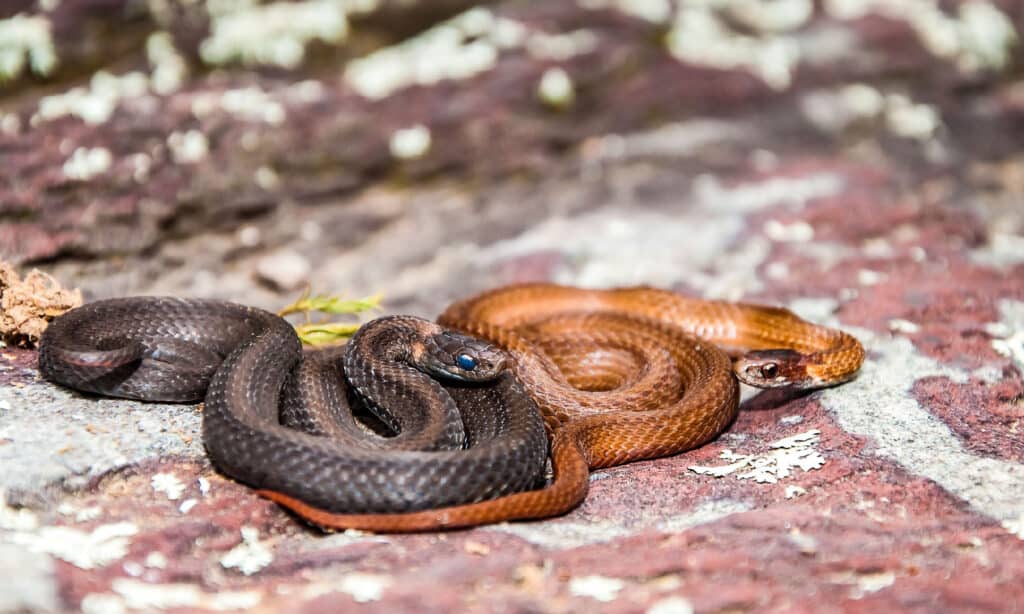
©iStock.com/JasonOndreicka
Despite having “northern” in its name, you can find the northern red-bellied snake anywhere in North America, south of Ontario. They’re some of the smallest snakes on this list, reaching only 12 inches at full size.
Like many other non-venomous Great Lakes snakes, the red-bellied snake is fairly harmless. Although they do have fangs, they aren’t large enough to do any significant damage to a human. Plus, they only use their fangs while hunting, and they’re shy enough to flee from a human.
You won’t find the northern red-bellied snake out of the water like you may some other species. However, they’re still a common sight in the wilderness areas surrounding the Great Lakes. Northern red-bellied snakes like to make their homes in the moist soil of wetland forests. This also means that they may favor your flowerbed if it receives regular watering! You can find them living under logs and stones where they catch their favorite meals: earthworms and slugs.
Western Fox Snake
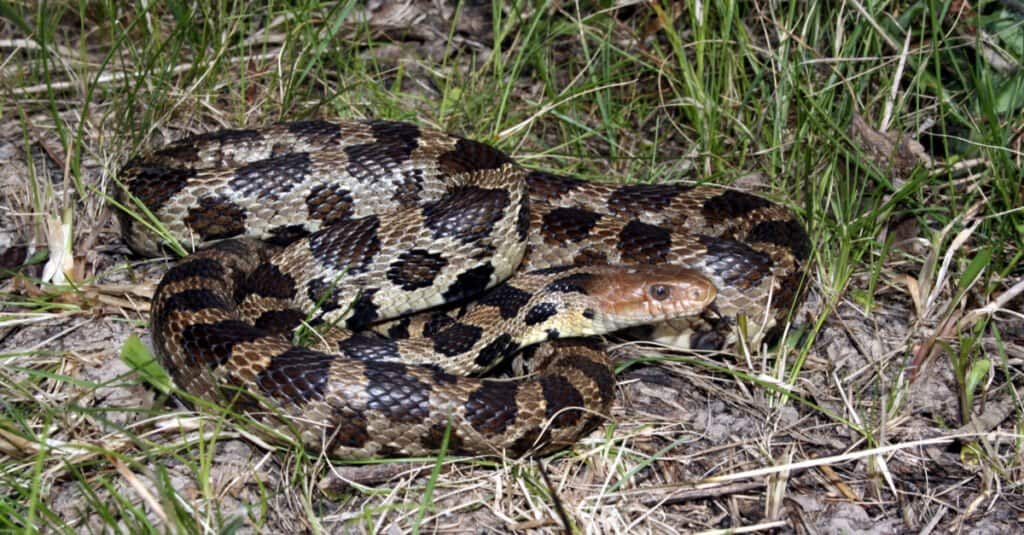
The only real difference between the two fox snake species is that the western tends to have more grey in the base color.
©Psychotic Nature/Shutterstock.com
The western fox snake is a more common find in the rivers and streams connecting the Great Lakes than the lakes themselves. They’re a type of rat snake common throughout North America, and their diet consists of everything from rodents to birds and eggs to frogs.
This snake is of fairly average size. As an adult, they can grow to be anywhere from 3 feet to 5 feet long. This, paired with their banded markings, makes it easy to mistake them for more dangerous snakes that live in the same area. However, they’re non-venomous.
As a result of this, they’ve adapted different ways to stay safe. First, like the eastern garter snake, the western fox snake may release a foul-smelling musk when disturbed. They’re also known to coil up and shake their tails as a way to mimic the venomous rattlesnake.
Northern Ringneck
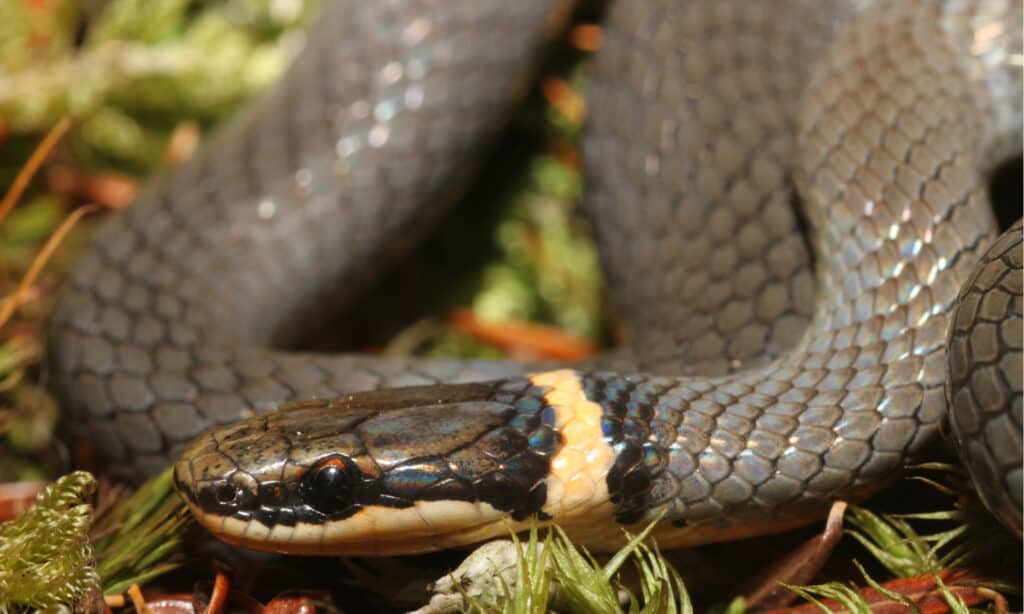
The northern ringneck snake is venomous.
©/Shutterstock.com
The northern ringneck is interesting in that it’s a venomous snake. However, because it is so small, its bite hardly affects humans and other larger mammals. Instead, this venom is used to paralyze their prey, which is equally as small as they are.
Like the western fox snake, the northern ringneck is more common in the Great Lakes basin rather than in the actual Great Lakes themselves.
The photo featured at the top of this post is © iStock.com/GlobalP
Discover the "Monster" Snake 5X Bigger than an Anaconda
Every day A-Z Animals sends out some of the most incredible facts in the world from our free newsletter. Want to discover the 10 most beautiful snakes in the world, a "snake island" where you're never more than 3 feet from danger, or a "monster" snake 5X larger than an anaconda? Then sign up right now and you'll start receiving our daily newsletter absolutely free.
Thank you for reading! Have some feedback for us? Contact the AZ Animals editorial team.






